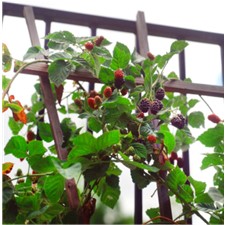Blackberry Traditions in the Backyard
Stephen Brueggerhoff, CEA – Horticulture; Texas A&M AgriLife Extension Service
5/24/2021
It is high time for harvesting the fruits of our labors, and I am looking forward to the tart sweetness of home-grown blackberries. I suspect blackberry picking is a tradition for most families, and I distinctly remember my parents taking us to a pick-your-own business when I was a tween, my brother, sisters, and I figuring out best methods for avoiding the sting from blackberry prickles to harvest glistening purple and black jewels.
Blackberries are an excellent choice for home fruit production, tolerating our hot humid weather and bearing fruit into summer. Cultivated blackberries are an improved form of native southern dewberry, varieties with thorned canes like large-fruited Kiowa and thornless variety like mid-season producing Ouachita, varieties with sweet or acidic taste as well as some producing almost 2-inch berries. Each plant  produces primocanes, canes that grow during the current season and floricanes, one year old flower bearing canes that die after fruit maturation. Production is dependent on their biology, the most successful varieties available for our region flower and set fruit on floricanes, and a few available varieties flower and set fruit on primocanes like early season, large-fruited variety Prime Ark Freedom. Always choose varieties requiring low winter chilling hours below 300 c.h. appropriate for our coastal climate and region. Browse online to Aggie Horticulture and explore an article with lists of blackberry varieties: aggie-horticulture.tamu.edu.
produces primocanes, canes that grow during the current season and floricanes, one year old flower bearing canes that die after fruit maturation. Production is dependent on their biology, the most successful varieties available for our region flower and set fruit on floricanes, and a few available varieties flower and set fruit on primocanes like early season, large-fruited variety Prime Ark Freedom. Always choose varieties requiring low winter chilling hours below 300 c.h. appropriate for our coastal climate and region. Browse online to Aggie Horticulture and explore an article with lists of blackberry varieties: aggie-horticulture.tamu.edu.
Cultivation is key to successful berry production. Plant on berms in well-draining acidic to balanced pH soils. While average soil pH in Brazoria County measures 6.5, it is always best to commit a soil test for an accurate measure of pH and nutrient availability to direct custom fertilizer applications. For general use, fertilizer products listing 3-1-2 ratio at 5 pounds per 100 feet of row is best distributed in split applications, first application right before budbreak and final in mid-June. Irrigation should be consistent starting at spring bloom and early fruit-set through to harvest and using drip lines laid at the base of the plantings along the rows to reduce disease pressure and conserve resources. Consider  training upright canes on a trellis or fence to keep fruit from decaying at ground contact, and tip-prune primocanes to encourage formation of floricanes. Reminder that all floricanes die after fruiting and should be removed annually by early spring. Mulch with organic material such as hay, pine straw or bark chips to reduce weed growth, reduce diseases, conserve water resources, and make low-hanging fruit visible for harvest. Pick when the fruit is fully mature as blackberry do not continue to ripen after harvest, and always refrigerate the same day as the berry is not shelf stable.
training upright canes on a trellis or fence to keep fruit from decaying at ground contact, and tip-prune primocanes to encourage formation of floricanes. Reminder that all floricanes die after fruiting and should be removed annually by early spring. Mulch with organic material such as hay, pine straw or bark chips to reduce weed growth, reduce diseases, conserve water resources, and make low-hanging fruit visible for harvest. Pick when the fruit is fully mature as blackberry do not continue to ripen after harvest, and always refrigerate the same day as the berry is not shelf stable.
I encourage all residents to continue to celebrate seasonal vegetable, fruit and nut traditions either at home or at community events. Brazoria County Master Gardeners are hosting a free Open Garden Day celebrating tomatoes on June 12 at our demonstration garden in Angleton, featuring tours of our gardens, best tomato growing methods, a canning demonstration, tomato tasting and produce judging. We are asking for pre-program registration for this free event to provide quality attention to our visiting public. On June 19, sponsored by Froberg’s Farm and Texas A&M AgriLife Extension, we are hosting a fruit field day workshop exploring best methods of growing blackberries, strawberries, figs and more, $20 and limited registration. For more program information and to celebrate our traditions of agriculture, browse online: brazoria.agrilife.org. Always delighted to serve, and I will see you in the garden.
